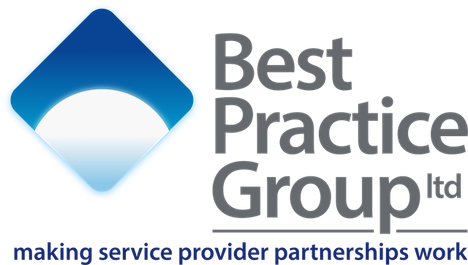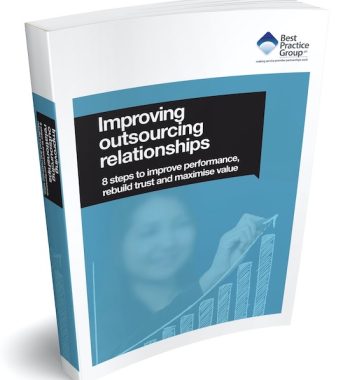
In recent years the massive tectonic plates of change have shifted significantly from a status-quo where organisations have been comfortable with long-term, hands-off arrangements with outsourced service provision across a variety of disciplines to one where every aspect of the relationship they have with their provider partners is under review.
Many have found themselves in outsourced service provider agreements that are so out of step with the reality of current needs that dramatic change is required to maintain the relationship or a breakdown will be inevitable. Others have to re-evaluate their needs due to the impending end of a contractual agreement and will take this opportunity to make sweeping changes to improve the adaptability of their next service provision partnership.
This article is about how some have found themselves in this uncomfortable situation, how to handle a relationship that seems to have become untenable, and the true size and complexity of the task of a seamless service provider transition if this really is considered necessary.
Service Provider Transition – Why you may be looking to make a change
The plethora of reasons why existing provider partnerships become strained – and why new contracts need to be more carefully considered – are centred on a few key factors: the rapid pace of technological change, the new economic and political environment many organisations now find themselves in, and the changing expectations of both clients and the end consumer of the service.
Some of the best examples of just how immense recent changes in the business environment have been are technology based. Mobile working, only possible thanks to swift advances in nationwide infrastructure, communications, hardware and software development, introduces a whole raft of new technology assets to an organisation which all need procuring, supporting and maintaining. As the humble tablet computer has only been widely available commercially for a few years, and just a little while earlier than that there was no such thing as a smartphone, mobile working is something that could not have been envisaged at the time of the creation of many older service provider agreements. Cloud computing is another example. It is now often perceived by service users to be far more cost-effective to cut out the middleman and go directly to the specialist provider that offers ‘best of breed’ support and expertise than it is to go through an outsourced service provider, and this is something that needs to be considered when new agreements are drawn up.
The business environment for organisations in both the public and private sectors has simply changed so much in recent years that agreements drawn up a while ago are unlikely to be congruent with an organisation’s medium- to long-term objectives.
It should be noted that not all outsourced service provider contracts come tumbling down due to a chasm of difference between the parties, as is the case with the widely publicised issues of some public and private sector organisations. Some simply come to a natural end – like Cumbria and Milton Keynes councils where all ended amicably – and this provides an opportunity for forward-thinking organisations to go back to the drawing-board and develop, from the ground up, new service provider strategies and agreements to suit them both now and into the future.
Can the service provider relationship be saved?
Problems with outsourced providers can often reach the point where the client organisation is considering whether or how to end the contract and switch to a different provider. However, the magnitude of such a move should never be underestimated as the operational, legal and HR commitment would be immense and, significantly, the internal expertise to achieve the desired end results may well now be lacking. Essentially, a seamless service provider transition can be perceived as more of an ideal, than a realistic expectation.
Services are outsourced for many reasons, but among them is the organisation’s perception that it should focus on the ‘core aspects’ of its service delivery. But there can occasionally be the factors of a lack of experience, expertise and manpower to handle such a task in-house. As the years go by, and the outsourced service provider is given increasing autonomy to provide services as they see fit (as long as they achieve the originally defined outcomes), two things happen. Firstly, the originally defined outcomes increasingly become out of step with what both the client and the end consumer require. Secondly, the in-house expertise in that service provision is reallocated to the vendor team and, as a result, the client’s ability to provide and understand the outsourced services diminishes.
Your first task when considering a change of providers is to reacquire a complete understanding of the service – how it is currently offered, maintained, monitored and improved – followed by the need to assess your organisation’s current and future demands; therefore, the reallocation of any service or services to another outsourced provider can be a monumentally complex undertaking.
Often it is better to open a dialogue with your service provider and attempt to establish better relationships, ways of working and contracts so that they better align to your current needs and expectations. Every attempt should be made to make your existing partnership work, before considering the rather extreme option of changing providers.
However, we acknowledge that a reasonable and amicable solution is not always achievable, so what follows is a very brief list of considerations when making the change.
The roadmap to change service providers
When, through natural course or dispute, a change in outsourced service providers is considered inevitable, there are a number of clearly defined steps to take in order to effect as smooth a transition as possible:
- Scoping of services: As previously mentioned, the first step to changing service providers is to gain a complete understanding of the objectives of your current agreement and the way in which existing service providers attempt to achieve these goals. But understanding what you do now often does not even scratch the surface of the task of preparing yourself for finding a new service provider. Take this opportunity to make a real change, initiate a company-wide audit of what each department needs now and into the future from its outsourced service providers, see how they interconnect and develop a full picture of the needs of your organisation to ask a new service provider to support, develop and innovate for.
- Governance to transition: Having the right client-side team in place to manage the hand-over from old service provider to new is essential. Relationships with outgoing providers should be kept as amicable as possible because their understanding of the service they’ve been supplying for years is invaluable, and relationships with new providers need to start off on the right foot to develop a collaborative approach that encourages innovation for mutual benefit. Communication is key, as is an accurate record of what is said to whom, along with a clear hierarchy for authorising activities and any deviations from the agreed plan of action.
- Resourcing through change: The full impact of a change in service providers in terms of manpower, technology and assets needs to be established in great detail, as do the often intricate issues surrounding any relevant TUPE and software licencing involved in the transition; just two of potentially many considerations to take into account. Inevitably resources lost when old contracts expire or are terminated will not only have an immediate effect, but may also have a knock-on effect throughout the organisation. Interdependencies between service provider and outsourcer need to be identified, and the full impact of change on your business must be uncovered.
- Manage, monitor and maintain: A successful outsourced service provider relationship relies on everyone pulling in the same direction to achieve the desired outcomes. Idealistic though this may sound, this is possible through building the right flexibility into your agreements, putting in place an agreed review process to always be appraised on the performance of the provider against KPIs, and actively encouraging service providers to the table to share innovative ways of achieving improved efficiencies.
Changing service providers is not something that can be rushed. There can be no swift transition or easy one-size-fits-all solution, but there are times when change is for the best. Though it is undeniably a complex and arduous task, it is possible to develop a successful and effective new outsourced service provider relationship, but only through a clearly defined and fully researched plan of action in partnership with a driven team of outsourced service providers committed to shared goals.
Thank you to Rod Matthews, SOCITM Consulting, for collaborating with us on this article.
Photo: Shutterstock

